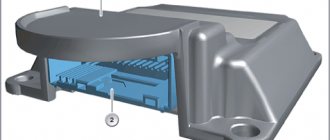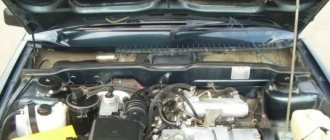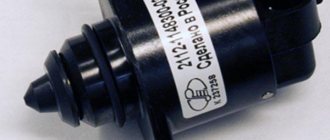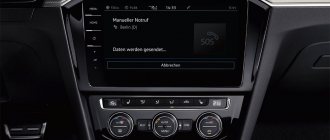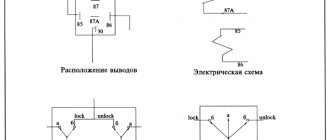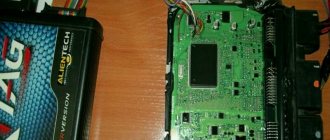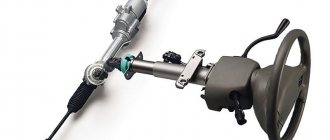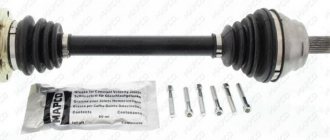Automobile accidents claim millions of lives every year. The shocking figure is directly related to the number of cars in the world, which has already reached some astronomical levels. That is why engineers, when developing modern cars, place the safety of the driver and passengers at the forefront. One of the latest inventions of modern engineers today is the integrated vsm system. In fact, this is exactly what will help the driver even in the most difficult and extreme road situations with the help of active vehicle control.
However, you can understand its principle of operation only by understanding the operating principles of the most famous security systems, which are familiar to many today.
I'll tell you about the operation of the VSM system
It’s no secret that the basics and principles of operation of such active security systems in Ike (in Russia they are installed starting with the Optima configuration) such as ABS, BAS, ESP, ESS, US.
But few people realize why the VSM dynamic steering stabilization system is needed in our car and what it is, since information about it is very scarce. Let's try to understand a little... This system does not work alone. It is tied to ESP, which, in turn, cannot exist without ABS. The VSM system consists of a symbiosis of an electric steering motor, ABS sensors, a steering wheel position sensor, a body tilt sensor, and an electronic control unit. Let's just say that while not being a separate system, it still works. According to the manufacturer, it should counteract incorrect actions by the driver, that is, in an emergency, the system should sense incorrect movement of the steering wheel and facilitate its rotation in the “right direction”, and in the “wrong” direction increase the force of rotation of the steering wheel.
No matter how many times I attempted controlled and uncontrolled drift of the car’s axles, I was unable to evaluate the effect of the moment of effort on the steering wheel. However, I still managed to feel it once. At high speed (more than 90 km/h) I drove the left wheels of the bike into a deep rut filled with water (partial hydroplaning resulted), the steering wheel became much “heavier”, not the slightest hint of being pulled out of my hands, and the car began to actively slow down. Another car without these assistants behaved differently in such a situation, trying to drift and tear the steering wheel out of my hands.
And so, working in conjunction with other safety systems and power steering, VSM helps: to reduce the effort on the steering wheel when parking and turning at low speeds; when turning at high speed, increases steering torque; increases the reaction force when returning the wheels to the middle position; adjusts the average position of the wheels of the front axle when driving on a road with a slope on one side, side winds and with different pressures in the tires; helps to avoid loss of steering control during a sharp start on an asymmetrical road surface (ice-asphalt); directional stability and steering precision are increased. The system, at first glance, is completely invisible, but significantly increases comfort and safety. In other words, this is a little assistant that combines the ESP system and steering))
Source
Stability control (ESP, DSC, ESC, VSC)
The exchange rate stability system (another name is the dynamic stabilization system ) is designed to maintain vehicle stability and controllability by identifying and eliminating a critical situation in advance.
Depending on the manufacturer, the system has the following names:
- Electronic Stability Program, ESP ;
- Electronic Stability Control, ESC ;
- Vehicle Stability Assist, VSA ;
- Vehicle Stability Control, VSC ;
- Vehicle Dynamic Control, VDC ;
- Dynamic Stability Control, DSC ;
- Dynamic Stability Management, DSM ;
- Dynamic Stability Traction Control, DTSC .
THIS IS INTERESTING: How to reset the Starline alarm to factory settings
The design and principle of operation of the exchange rate stability system are discussed using the example of the most common ESP system.
Stability control system
Stability control is a higher level of active safety system.
The ESP system includes the following systems:
- anti-lock braking system (ABS),
- brake force distribution system (EBD),
- electronic differential lock (EDS),
- anti-traction system (ASR).
The directional stability system has the following device:
- Control block;
- hydraulic block;
- wheel speed sensors;
- brake pressure sensor;
- acceleration sensor;
- rotation speed sensor;
- steering angle sensor.
Using sensors, the dynamic stabilization system evaluates the driver's actions and vehicle movement parameters.
How the stability control system works
The occurrence of an emergency is determined by comparing the driver’s actions and the vehicle’s movement parameters. If the driver's actions differ from the actual driving parameters of the vehicle, the ESP system is activated.
Based on the signals received from the sensors, the electronic stability system activates the relevant safety systems and controls their operation.
Source: https://www.infocar.ua/term_stability.html
Integrated Active Management System VSM: What is it?
Systems to ensure vehicle stability in different driving conditions have long ceased to be options available only in expensive models. Abbreviations ABS, EPS, etc. are present in the description of most configurations. The driver of a modern car is already accustomed to the fact that sharp braking on a slippery road will not lead to skidding, and when turning the car itself will choose a safe trajectory.
To implement these functions, sensors and devices influencing wheel drives and engine traction are used. Moreover, each system uses its own equipment depending on its purpose. From an engineering point of view, it would be logical to combine the capabilities of these systems. The result of this technical solution is an integrated active management system, or VSM.
Precautionary measures
The presence of a mass of electronic systems in a car can also play a cruel joke on the owner. The negative side is that the owner of the Creta begins to rely too much on electronics, neglecting safety precautions while driving.
IMPORTANT TO REMEMBER
– electronic systems
are NOT an
unconditional guarantee of safety.
However, you definitely shouldn’t rely on electronics alone.
This means that the presence of the VSM complex in the SUV package does not mean that you can drive recklessly with impunity. The VSM system itself cannot prevent an accident. Therefore, it is always necessary to maintain a distance from the car driving in front and not exceed the speed allowed by the rules. This is especially true in bad weather, on uneven, wet or slippery roads.
Separately, it is worth noting the moment associated with the wheels of the Hyundai Creta. They should be the same. If the tires or wheels of the crossover are different in size, the VSM system may not work correctly. Therefore, driving with wheels of different sizes is highly not recommended, especially if we are talking about a long trip.
Over the past couple of decades, industry leaders in automotive design and manufacturing have been confronted with the serious problem of low driver readiness to operate a vehicle in high-risk environments. Many facts and police statistics say that the ability to drive a complex, heavy and powerful passenger car without killing yourself and others is no longer enough for the average driver.
The first, focused on a comprehensive solution to the problem, was the integrated active control system VSM. In essence, a new computer unit was combined with a system of sensors and control modules for anti-lock brakes and a directional stability system.
What functions are assigned to the integrated active control system VSM:
- obtaining from all available vehicle sensors the most reliable information about the current state of the vehicle;
- comparison of the objectivity of the ABS and ESP control commands with the tendencies of the driver’s actions and comparing them with the optimal possible options stored in memory;
- indirect VSM intervention in the operation of the steering wheel, engine, brake system and gearbox.
Important! VSM differs from many intelligent assistant options in that it helps the driver act beyond information or recommendations.
What is the VSM system and why is it needed?
VSM is an abbreviation for Vehicle Stability Management system, that is, “vehicle stability management system.” The term is used mainly in the products of the Korean automobile industry. The word “integrated” in Russian interpretation specifies that this safety feature uses the potential of the systems already available on the car - ABS, ESP, EBD and others.
Another key term is “active management.” It should be taken literally - this safety device takes an active part in driving the car through the steering wheel. The VSM system neutralizes incorrect steering movements and assists the driver. List of tasks to be solved:
At the same time, the system does not require any additional sensors - it uses information received from the basic subsystems for maintaining motion stability.
The above-mentioned problems are solved by influencing the electric power steering. The possibility of triple influence - on the brakes, gas and power steering - significantly increases the reliability of stabilizing the vehicle's position in an extreme situation. Manufacturers also emphasize this when comparing VSM with the traditional ESC stability control system. While ESC claims, VSM provides “maximum traction on each of the four wheels.”
Information feed
The high-speed line Chelyabinsk - Yekaterinburg is named among the priority projects in the development program of Russian Railways until 2025. The other day it was approved by Russian Prime Minister Dmitry Medvedev.
The priority direction is the transcontinental corridor "Eurasia" , which also includes the Chelyabinsk - Yekaterinburg , this is stated on the official website of the Russian government. JSC Russian Railways plans to allocate 402 billion rubles for the construction of the Ural high-speed railway.
What prospects does the expressway open up?
According to experts, the project can provide an economic effect already at the construction stage. The implementation of the project could bring tens of billions of rubles into the region’s economy, provided that Ural companies take part in it.
With the completion of the construction of the Ural high-speed railway Chelyabinsk - Yekaterinburg, a third agglomeration will appear in Russia after Moscow and St. Petersburg.
The highway opens up long-term prospects for business development in the two Ural regions. According to the governor of the Sverdlovsk region Evgeny Kuyvashev , the rapprochement of the two largest Ural cities will make it possible to create one of the largest centers of concentration of human resources in the Urals and Siberia.
Residents of the two Ural capitals will have the opportunity to quickly and safely travel from Chelyabinsk to Yekaterinburg and back. The travel time will be a little over an hour. For comparison: by bus this distance is covered in almost four hours, by car the distance is covered in at least two and a half.
Details
• In mid-February, Russian Prime Minister Dmitry Medvedev included the Ural high-speed railway in the Spatial Development Strategy of the Russian Federation until 2030. • The length of the highway is 200 kilometers. • If the project is implemented, travel time from Yekaterinburg to Chelyabinsk will be reduced to 1 hour 10 minutes.
Natalya Firsanova
Source: https://2goroda.ru/infobar/blizhe-k-mechte-vsm-chelyabinsk-ekaterinburg-voshla-v-chislo-prioritetov-rzhd
How the VSM system works
Coordination of traditional anti-lock and stability control systems in combination with access to the steering wheel takes the vehicle control system to a whole new level. At the same time, the machine does not become a robot, because the VSM system operates softly under normal conditions, in addition to manual control. The driver will feel its presence by the following signs:
This not only provides increased operating comfort. By setting the required force on the steering wheel, the system actually tells the driver how to rotate the steering wheel in a particular situation. If he tries to twist it in the wrong direction, he will immediately feel resistance.
This remedy will also help to avoid an unpleasant situation during aquaplaning, when a car drives into a puddle at high speed and the grip on the road is lost. In this case, the system automatically reduces the speed and at the same time increases the force to turn the steering wheel, neutralizing the risk of loss of control.
Visualization
Remaining competitive in business requires consistent process improvement and monitoring. It is not enough to receive performance updates only when the VSM team gets together. Indicators need to be monitored regularly, some even daily or hourly. How do these numbers track in the real world? Most organizations create a report or series of reports that show the data they are interested in. Dashboards and dashboards are also a great way to display current metrics. The example shown in Figure 6 is an example of a Lean Teams USA dashboard.
Figure 6
There are many tools that can be used to track and report on the status of the value stream throughout the process being mapped. Some will even provide support for other development lifecycle management features. When considering the development process across a large enterprise, stand-alone value stream management solutions can track multiple metrics and provide detailed reporting and analytics throughout the development process from concept to delivery. Such a dashboard can be a powerful tool for displaying near real-time flow state data. The dashboard allows the viewer to easily analyze and identify specific issues and bottlenecks.
Whatever tool you use to track current health metrics, you need to make sure that it is accessible to all those teams and team members so that it provides a holistic perspective for each team involved in the stream and is a meaningful part of the value stream.
Ultimately, the goal is to develop a company culture that provides the best product to meet or exceed customer needs and expectations. This is ultimately achieved through continuous improvement of value streams. As our customers' needs and expectations change, our value streams must also change and continually evolve.
Material developed by Plutora
How and when the VSM system is activated
This system is used as an add-on over other traffic stabilization aids, and automakers usually define it in their descriptions as an addition to their list. Existing indicators can be used to signal activation, for example, ESC and EPS activation in Hyundai Accent or Creta.
Active Steering mode is switched off when driving in reverse or on a slope. Speed limits for inclusion are speeds above 15 km/h on a road with turns and above 20 km/h when braking. You can disable or enable this mode manually by pressing the ESC OFF button. The activation of the equipment is felt by ear and by a slight pulsating movement of the brake pedal.
Source
What can BCM do?
Reading the logbooks of Polo Sedan owners, I noticed that in order to install certain “goodies” for themselves, they sometimes resort to replacing the on-board electronics unit (Body Control Modul), or more simply, the BCM. A good example is the installation of cruise control. since not every BCM installed on a Polo sedan supports this function and the whole point is the absence of four pins in the BCM connector.
And I started thinking – what could potentially support the HSR? When I studied how the BCM on a Tiguan was tripled from a friend, I noticed that all the lighting goes through the BCM, and there it is possible to implement not only standard lamps as running lights, but also PTF and low beam, and in various combinations, there even The “strobe lights” function works - when the distant flashes, the PTFs are turned off. Is this possible for the Polo Sedan? To begin with, I found out which BCM I have installed. You can find out the number in several ways, below are the ones I know: 1) Through the VCDS cord 2) Through ELM Bluetooth and the Carista program (even in free mode) for Android 3) As I did - Look on site, it is located behind the relay block, above the fuses , the information plate is located below
I slipped a camera with a flash, took a photo of the sign (I succeeded on the 4th try), and I didn’t have to climb anywhere in awkward positions.
I have it number 6R0937087P, type - PQ25 (as I understand it, means that the unit has 2 connectors for connection) I found a photo of the removed unit on the Internet using the number:
Also, for comparison, I found out which BCM is installed in the 2013 Polo Sedan Hi+Premium from a friend - 6RU937087F:
I noticed that in the second case there are more empty spaces in the pins, and I wanted to know which pins are involved in what. In order to understand this, you need information on the pinout of VCM connectors, and I downloaded and installed ELSA.
Now I present the most complete possible pinout (Signals on the on-board network control unit) of the BCM type PQ25, obtained from the study of pinout tables and electrical circuits of Polo sedans and hatchbacks, and other VAG models with blocks of this standard size of various configurations. Perhaps it will be useful to someone.
The order of the columns is as follows: Connector number P
/Contact number
K
/presence of pin for mine 6R0937087P
N
/description
Cl R K n Terminal
A 1 - Output, signal to the high beam relay or Output, signal to the right high beam A 2 - Output, signal to the left low beam A 3 - Output , battery separating relay (*for T5) A 4 √ Output, interior lighting signal, when the door is opened A 5 — Output, power supply to the daytime running light lamp on the right A 6 — Output, signal to the rear fog lamp A 7 √ Input, fog light switch headlights A 8 — Output, separating relay of the CAN-drive bus A 9 — Emergency Brake Button (VW UP, Seat) A 10 √ Output, signal from the electric motor for unlocking the luggage compartment lid A 11 √ Output, signal to the electric motors for locking the central locking, for all doors A 12 √ Output, signal to the driver's door central locking motor A 13 √ Output, signal to the central locking motors, for all doors A 14 √ Input, ground signal (31), central locking A 15 √ Output, signal to the central locking motors, door front passenger and rear doors A 16 √ Input, power supply signal (30), central locking A 17 √ Input, rear left door central locking signal A 18 √ Input, rear right door central locking signal A 19 √ Input, limit switch signal driver's door A 20 √ Input, front passenger's door limit switch signal A 21 √ Input, front passenger's door central locking actuator signal A 22 √ Input, driver's door central locking actuator signal A 23 √ Input, signal for the unlocking button in the tailgate handle/ trunk lid A 24 √ Input, driver's door central locking signal A 25 √ Input, interior locking button signal A 26 √ Input, rear right door limit switch signal A 27 √ Input, hood limit switch signal A 28 √ Input, button signal hazard warning lights A 29 √ Input, horn switch signal A 30 √ Input, tailgate/tailgate locking signal, position 2 A 31 √ Input, tailgate/tailgate locking signal, position 1 A 32 √ Input, indicator switch signal turn signal, right A 33 √ Input, turn signal switch signal, left A 34 √ Input, rear left door limit switch signal A 35 √ Output, signal to the sliding sunroof control unit A 36 √ Heated seat switch signal A 37 - Input, switch signal mode of auto-on external lighting A 38 √ Output, signal to the heating elements of the exterior mirrors A 39 √ Input, ground signal (31) A 40 √ Output, signal to the right side lamps A 41 √ Output, signal to the left side lights A 42 √ Input, power signal (86s), ignition switch A 43 √ Input, brake pedal position signal A 44 √ Input, power signal (15), ignition switch A 45 √ Input, side light switch signal A 46 - not used A 47 √ not used A 48 √ Output, signal to the sliding sunroof control unit A 49 √ Output, signal to the headlight cleaning system relay A 50 √ Output, signal to the heated windshield relay A 51 — Output, signal to the entrance and footwell lighting relay A 52 √ Output, signal to the fuel pressure relay A 53 - not used A 54 - Input, power supply signal (75a), ignition switch A 55 √ Output, signal to the starter lock relay (only vehicles with automatic transmission) A 56 √ Output, signal to the hazard warning light indicator A 57 √ Output, signal to the interior security switch indicator light A 58 √ Output, signal to the central locking indicator light A 59 √ Output, signal to the interior door locking indicator light A 60 √ Output, signal to the heated rear window warning lamp A 61 √ Output, signal to the heated windshield warning lamp A 62 - Input, signal to turn off the high beam / signal to the high beam (flashing) A 63 - Input, signal for the power supply (30), left headlight A 64 √ Input, power signal (30), heating elements of exterior mirrors A 65 √ Output, power signal (30), interior lighting and luggage compartment lighting A 66 √ Input, power signal (30), interior lamps A 67 — not used A 68 √ Input, power supply signal (30), wipers A 69 √ Output, signal to wipers, position 1 A 70 √ Input, signal to ground wipers A 71 √ Output, signal to wipers, position 2 A 72 √ Output, signal to horn A 73 √ Input, power signal (30), horn B 1 - Output, power supply for switches and instrument cluster illumination or Output, signal to left high beam B 2 - Output, signal to right low beam B 3 - Output , power supply to the daytime running light lamp on the left B 4 — Output, power supply for the illumination of switches and instrument cluster B 5 √ Output, control signal to the LED running light of the left gas discharge headlight B 6 √ Output, control signal to the LED running light of the right gas discharge headlight B 7 — Output, power to license plate light B 8 — Input, signal to turn on high beam B 9 √ Output, signal to left fog light B 10 √ Output, signal to right fog light B 11 √ Input, signal to power (30) , fog lamps B 12 √ Output, signal for reversing lights (only vehicles with automatic transmission) B 13 √ Input, power supply (30), turn indicators and brake lights B 14 √ Output, signal for left turn indicators B 15 √ Output, signal for right turn signals B 16 √ Output, signal for brake lights B 17 √ LIN bus, door control unit and steering wheel switches B 18 √ CAN-Low, drive B 19 √ CAN-High, drive B 20 √ CAN-High, comfort B 21 √ CAN-Low, comfort B 22 √ CAN-Low, diagnostics B 23 √ CAN-High, diagnostics B 24 √ LIN bus, sliding sunroof control unit, rain and light sensor, interior security sensor B 25 — Input, signal from the contact strip in the left sliding door (*for T5) B 26 — Input, signal from the contact strip in the right sliding door (*for T5) B 27 √ Output, windshield wiper signal, position 1 B 28 √ Input , front passenger door central locking signal B 29 √ Input, signal from the daytime running light switch B 30 √ Input, signal from the interior security switch off B 31 √ Input, signal from the rear window heating button B 32 √ Input, signal from the windshield wiper limit switch B 33 √ Input, signal from the heated windshield on/off button B 34 √ Output, signal for the brightness of the backlight of switches and instrument cluster (58d) B 35 - not used B 36 √ LIN bus, alarm siren B 37 - K-line signal, diagnostics B 38 √ Input, ground signal (31), electronics B 39 √ Input, power signal (30), electronics B 40 √ not used B 41 √ not used B 42 — Input, brake light switch signal B 43 — Input, signal from the rear fog light switch B 44 √ Input, cruise control “Set” signal B 45 √ Input, cruise control “on/off” signal B 46 √ Input, cruise control “Reset” signal control B 47 √ Input, cruise control Cancel signal B 48 √ Input, reverse light switch B 49 √ Alternator (L) signal B 50 √ Input, starter relay signal B 51 √ Input, power supply signal (75a ), ignition switch B 52 √ Input, power signal, low beam headlights B 53 √ Output, windshield wiper signal, position 2 B 54 - CAN-High, instrument cluster B 55 √ Starter interlock signal (only for vehicles with automatic transmission) B 56 √ Input, signal from the tailgate lock actuator B 57 - CAN-Low, instrument cluster B 58 √ Input, signal from the heated exterior mirror switch B 59 √ Input, reference voltage, plus (30) B 60 √ Input, reference voltage, ground ( 31) B 61 √ Output, signal to the washer pump motor and rear window wiper motor B 62 √ Input, signal for the windshield wiper interval B 63 √ Output, signal to the rear window heating element B 64 √ not used B 65 √ not used B 66 √ not used B 67 √ Input, power signal (30), rear window heating element B 68 - Input, power signal (30), right headlight B 69 - not used B 70 - not used B 71 - not used B 72 - not used B 73 - not used
I also posted a file with pinouts on the cloud to make it easier to study.
You can read information on connector pinouts, article numbers and numbering of BCM block terminals in Nikolay’s post nikbyte BCM block connector pinouts
From this table, regarding my unit, I made the following conclusions (theoretical for now): 1) You can install cruise control (then you still need a steering column switch with cruise buttons and accompanying “accessories” for connection) 2) Even if you install a bumper from a hatch with two-lamp PTF (one lamp is PTF, the second is running light), my unit does not support running lights (pins A5 and B3 are empty). Therefore, either accept it or change the BCM 3) You can change the PTF connection diagram and use the BCM in the diagram (pins A7, B9, B10, B11). Then, through coding, it will be possible to use them as so-called corners (Corner light). When you turn on the turn signals or turn the steering wheel (if there is a steering wheel position sensor (on vehicles with ESP)), only the corresponding left or right PTF will light up 4) Headlight washers are supported, but then you need to install them - you need a bumper from a hatch with a washer and accessories for him
Source
In the distance along Piterskaya: the route to the northern capital cost 520 billion
The super-expensive highway is good, but not completely ready
On November 27, 2022, the M-11 Neva highway was inaugurated. The event was attended by Russian President Vladimir Putin himself. The track was officially opened with the passage of the latest models of the Russian automobile industry, including the Aurus Senat S600, KAMAZ-54901, and the expeditionary UAZ Patriot. A test conducted the day before showed that along the M-11 you can get from one capital to another in 6 hours 14 minutes, while on the M-10 the journey takes at least two hours longer.
At the same time, the federal construction project turned out to be very controversial and could easily become the talk of the town, no worse than the Zenit Arena and the Vostochny cosmodrome.
Dear highway!
The M11 highway, connecting the two largest cities in Russia, runs from the Moscow Ring Road to the junction with the Ring Road, which goes around St. Petersburg. The total length of the highway is almost 670 km. There are 16 toll booths, six multifunctional service zones, and 15 gas stations on the M11. The M-11 highway runs parallel to the long-existing federal highway M-10 "Russia".
In six places you can take the free route and vice versa. Let us remind you that the cost of travel along the entire M-11 highway connecting Moscow and St. Petersburg on a weekday for passenger cars will be 1,820 rubles, and if you use a special transponder - 1,331 rubles. On weekends (and Friday) travel will cost more - 2020 rubles. Using a transponder you will need to pay 1,494 rubles.
One of the largest concessionaires of the Neva is Magistral of Two Capitals LLC, the general contractor is the Turkish company Ic Ictas Astaldi Ica Insaat Anonim Sirketi.
Let us recall that the concept of the M-10 backup began to be discussed back in the 1970s; the final decision to build the route was made in 2006. At the same time, M-11 is currently the largest example of public-private partnership in the history of Russia.
M-11 was built in sections under concessions with the participation of the North-Western Concession, "Two Capitals Highway" and other companies. Moreover, the total amount of private business investment is 148 billion rubles, which is about a quarter of all investments. Under the terms of the concession, the private owner will be able to return the money over the next 25 years.
State participation in construction looks much more voluminous - 372 billion rubles. The total cost of the road is 520 billion rubles. And this amount is more than double the cost of the Crimean Bridge.
How much can you build?
The highway was built for almost 10 years - since the spring of 2010, its operator is the state. And it’s not for nothing that the project is considered a long-term construction project. For example, as Nezavisimaya Gazeta writes, over the past 30 years China has been building highways at an average speed of 4,750 km per year, or almost 400 km per month. That is, the construction of a route of similar length could take only one and a half to two months.
According to experts, the extreme delay in construction of the road is explained by the fact that the highway was built in separate sections, each of them under a separate concession agreement. Various approval processes significantly increased the time frame, and each section of the road was put into operation at different times.
Another culprit behind long-term construction is the extremely lengthy procedure for purchasing land for construction.
The third pillar on which long-term road construction stands is called irregular financing. Huge funds initially allocated for the northwestern highway were eventually redistributed to other infrastructure projects. And all this against the backdrop of an unstable economic situation.
Thus, for a number of sections of M11, positive state expert opinions were received back in 2011–2012, and it was assumed that the main phase of construction would take place in 2014–2015. Instead, the main period was postponed to 2018–2019, which is characterized by completely different macroeconomic conditions.
The problem is that it is difficult to find a major investor for large investment projects, even with government guarantees. This is also due to the fact that infrastructure is developing extremely slowly outside of large cities and regional centers.
About forces and moments
The torque developed by the motor goes to the wheels, and the car begins to move. This is a very simplified way to describe the process of moving it. However, when starting to move, maneuvering and braking, a wide variety of forces act on the car, and the nature of their influence depends on the speed, road condition and driver actions.
Sometimes these actions are erroneous and incorrect, which can result in an accident. To avoid this, developers have come up with more than one electronic device that assists the driver in difficult conditions. Without touching on them all, it is enough to mention the most famous and well-known ones:
The operation of any of these active control devices is based on constant monitoring of signals from sensors. Based on them, the controller determines the discrepancy between the actual driving mode of the car and what it should be, and it also takes the necessary measures, for example, it reduces the speed, slows down or unlocks the wheel, and changes the engine operating mode.
⇡#Hi-Tech
Almost all the high technologies that were previously the prerogative of more expensive models are now available for the updated Toyota crossover. The fully loaded RAV4 now offers the same hi-tech capabilities as the new Land Cruiser (which was also recently redesigned) and some of its competitors. True, the test car was deprived of most of the options, and therefore I can only guess about ease of use, such as navigation and voice control. In this regard, I will limit myself to a brief listing of all the “goodies” that a buyer of a Japanese crossover can theoretically receive.
The 2022 model may be equipped with an interesting option - a panoramic viewing system, which in the USA is beautifully called Bird's Eye View. It works like this: wide-angle cameras are installed on four sides of the car, the image from which is combined into a single picture of a circular seamless panorama and then displayed on the display of the Toyota Touch 2 multimedia system. Moreover, you can view the car’s surroundings both statically and on the move - for example, when overcoming obstacles or when driving in particularly tight conditions.
The Toyota Safety Sense package includes several active safety systems. There is a system for automatically switching high beams to low beams (and vice versa), which constantly assesses the level of road illumination and takes into account the headlights of oncoming cars, as well as the taillights of passing cars.
Lane Departure Warning recognizes road markings and alerts the driver if he has crossed the line but has not activated the turn signal, both visually and audibly. If the driver continues to violate the traffic lane and generally behave, according to the computer, inappropriately, the system for monitoring and informing about driver fatigue will prompt the tired pilot to stop and rest.
RAV4 can also warn about the threat of a frontal collision: if the distance to the vehicle in front decreases too quickly, the system will warn the driver about the threat, and, if necessary, perform emergency braking.
In cruise control mode, the RAV4 is able to maintain a safe distance from the vehicle in front, automatically slowing down if it detects a vehicle moving slower than a set speed value.
The RAV4 is trained to recognize road signs and then display them on the 4.2-inch on-board computer display. Moreover, if the driver does not comply with the requirements of the signs (for example, exceeds the speed limit), the car will use sound signals to remind the reckless driver of the importance of traffic rules.
Of all the high technologies that the test crossover had, there was only the Toyota Touch 2 multimedia system (and then with reduced functionality, since it was deprived of navigation and voice control), plus an on-board computer with a 4.2-inch display on the dashboard. Touch 2 is not a new device, but is well known from other Toyota cars. In the basic version, the system’s capabilities are typical and limited to the simplest functions: radio, playing music from external storage media, communication with a mobile phone via Bluetooth (receiving and sending calls, working with SMS messages, synchronization with the contact book.), as well as displaying information about trips with calculation of average fuel consumption. Using the Touch 2 center is quite convenient - in addition to the 6.1-inch resistive touch screen, there are also several large physical keys located on the sides of the display to control the system. The system menu itself is organized simply and does not feature overly deep catalogs, in which you can get lost if you are unaccustomed to it, as, for example, in the system of BMW cars.
Automobile accidents claim millions of lives every year. The shocking figure is directly related to the number of cars in the world, which has already reached some astronomical levels. That is why engineers, when developing modern cars, place the safety of the driver and passengers at the forefront. One of the latest inventions of modern engineers today is the integrated vsm system. In fact, this is exactly what will help the driver even in the most difficult and extreme road situations with the help of active vehicle control.
However, you can understand its principle of operation only by understanding the operating principles of the most famous security systems, which are familiar to many today.
VSM Active Management System
Another somewhat specialized but useful integrated management system, VSM, is worth mentioning. It does not work by itself, only in combination with ESP and ABS. If ABS provides stability during braking, TCP during acceleration, ESP prevents lateral movements and stabilizes the vehicle’s position during maneuvers, then the VSM system is, as it were, integrated, combining the work of all other components and the actions of the driver.
The VSM system combines the electric steering motor, ESP and ABS. As manufacturers of cars with VSM claim, the stabilization control system counteracts erroneous driver actions , i.e. if in a critical situation they perform incorrect actions to control the car, then VSM will counteract them.
In a more understandable way, this means that if the driver turns the steering wheel in the wrong direction when performing a maneuver, this will require significant effort from him. Whereas when the steering wheel moves correctly, nothing like this happens.
Is it possible to fully automate the control system?
Sometimes it is easier and much cheaper to teach the necessary skills to a system that already exists than to purchase a new one. The specialist who will manage the inventory must submit timely reports on reserves. Moreover, there are always several classes:
- the main one is both the worker and the one who remains in case of delays and sales growth;
- temporary - one who rises or falls during the season, defects and illiquid products.
This will have to be monitored taking into account all changes
It is important to be able to analyze multiple factors. In addition, the unstable volume cannot be predicted; here the expert will have to work based on his experience and instinct
As for the defective product, it is necessary to take action against it and find out the reasons for its occurrence, as well as assess the scale of the disaster.
Problems that VSM solves
If we try to generalize what problems such an integrated system solves, we can note the following:
Thus, the VSM system is engaged in stabilizing the position of the car on the road while driving in the same way as ESP, ABS and other devices with similar purposes. The difference between the two will be that VSM, through the electromechanical booster, acts on the steering wheel and not on the brakes . In other words, the effect on the steering wheel and brakes is combined.
This is especially true when acceleration or braking occurs on different surfaces (one wheel on ice, water or other surface, the other on asphalt). As a rule, the car begins to pull to the side as a result. To correct the situation, control signals are sent to the steering mechanism, correcting the position of the car. In principle, the situation considered is typical for the operation of such a control system. The possibility of skidding may occur again during sharp maneuvering, in which case VSM will also help keep the car from skidding.
It should be noted that such a device is not included in the standard equipment of the car.
An active control system such as VSM primarily ensures vehicle stability on course when driving on different surfaces under different wheels. In this case, not only signals are generated to brake an individual wheel, but also to the steering, thanks to which the car continues to move along a given course and it is possible to avoid skidding.
Source
Conditions under which you need to turn off the ESP stabilization system
Scientifically, ESP is an electronic vehicle dynamic stabilization system - Electronic Stability Program. Different manufacturers call it differently: Volkswagen, Audi, MercedesBenz call it ESP, Hyundai - VSM, Honda - VSA, and BMW, Jaguar, Land Rover - DSC.
The dynamic stabilization system or vehicle stability control system developed on the basis of the ABS anti-lock braking system, the ASR anti-skid system, the TCS traction control system and other various systems that have different names, but use the same principles of wheel traction control.
When the vehicle is moving, the ABS/ESP control unit (computer) analyzes the position of the vehicle using various sensors placed on the car.
Using this data, the ESP system can adjust the braking force between the wheels, applying the brakes to a specific wheel if necessary to level the vehicle, thereby preventing the vehicle from lateral movement or skidding.
As a result, the ESP system provides the car with good dynamic balance.
According to the US Transportation Security Administration (unfortunately, there are no similar studies in our country), the ESP system can reduce passenger car accidents by more than 30%, and SUV and crossover accidents by 50%.
But since this system is so useful and directly affects road safety, why did automakers provide the ability to disable the vehicle stabilization system? So, why the ESP system is useful and when it should really be turned off is in our review.
1) Drift, quick start
If you are a racing driver, like to drift your car, or don't want the stability control system to interfere with your car's handling, you should turn off ESP. Otherwise, the system will prevent you from drifting when the car's wheels begin to lose traction. If you do not turn off ESP, the system will limit wheel slip not only by braking the wheels, but also reduce the transmission of torque to them.
2) Driving on sand or mud
When going outdoors or driving through mud, we advise you to also turn off the ESP system so that the electronics do not brake some wheels that begin to slip on a road that runs through rough terrain. Also, off-road driving requires power, which will be limited by the dynamic stabilization system, as a result of which the car may get stuck. If you are already stuck, then you also need to turn off ESP, as it will prevent you from leaving.
3) Rain and snow, slippery roads: when driving uphill
We know that in rainy and snowy weather, the ESP system is excellent at helping drivers keep their car on slippery roads. Thanks to this, we feel more confident behind the wheel in bad weather.
And all due to the operation of electronics, which perfectly regulates the stability of the machine even in difficult weather conditions. But if you are driving uphill on wet or slippery roads, it is better to turn off the ESP system. This is necessary so that the car climbs smoothly uphill.
Otherwise, the ESP system may, on the contrary, contribute to the car skidding when going uphill.
4) The vehicle is equipped with snow chains
If your car is equipped with snow chains, in this case we would also advise you to disable the ESP system. Otherwise, the ESP system will transmit incorrect data to the stabilization system control unit, as a result of which the car will not align on the road as desired. Ultimately, this will affect driving safety. In this case, it is better to disable ESP.
How does disabling the ESP system work on different cars?
All cars, as we know, are created differently. The algorithm of the ESP system is also different. Especially when disconnected. For example, in some cars, pressing the ESP OFF button once only turns off the ABS system first. This is how, in particular, disabling ESP works in the Hyundai Creta crossover. If you then press the button again within a few seconds, the stabilization system will turn off completely.
Source: https://1gai.ru/publ/522162-pochemu-sistemu-stabilizacii-esp-mozhno-vyklyuchit-vot-kogda-nuzhno-otklyuchat-esp.html
